7 weeks
Product Design, Visual Design, Mobile Design
Product Designer, UX Researcher
Iris Cai, Gia Marino, Laura Pedrosa, Patricia Yu
I led product feature and interface design of Commutable, supported problem space research and usability testing.
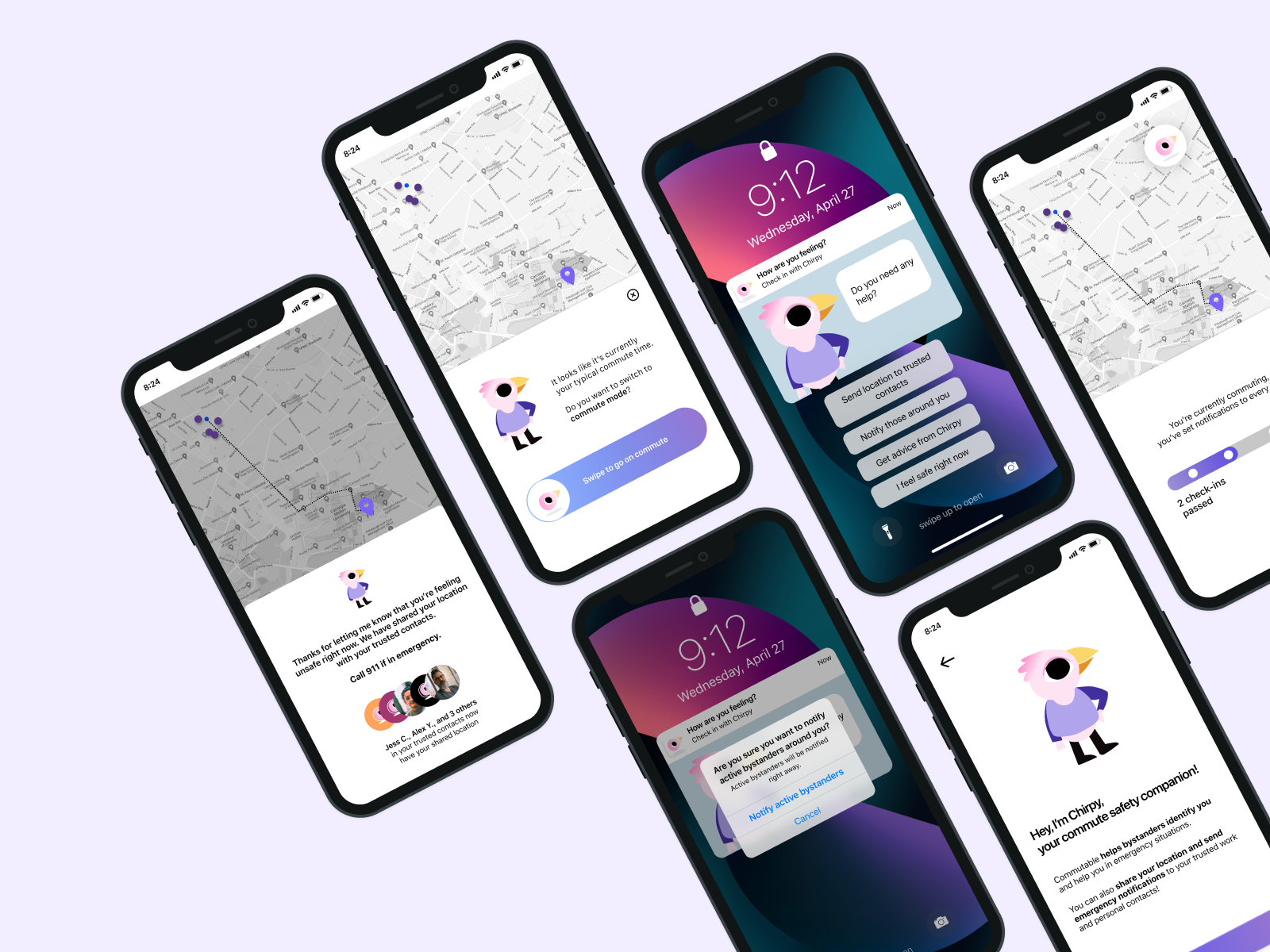
Commutable is a mobile app that provides real-time assistance to women and minority commuters in urban spaces. By integrating with workplace tools such as Slack and Microsoft Teams, Commutable helps establish support system within the co-working community in the case of emergency. Additionally, Commutable enables bystanders to assist users during moments of uncertainty. Overall, Commutable serves as a dependable travel companion for women and minority commuters.
[insert product showcase]
Chefs can order their kitchen staples from the app’s homescreen to take the shortcut and save time.
.gif)

Easily add a product, customize it, or make it a favorite for future use.
Chefs can favorite one of their saved lists to quickly reorder everything they need, with just one click.


Details such as color, quality, and spiciness are listed for easy reference since every chef has their own needs for dishes they want to create.
When a product has low stock, the app gives chefs a distinct warning and quantity left to avoid chefs from ordering amounts Amber Waves is unable to fulfill.

Since the COVID-19 pandemic began in 2020, many populations around the world have experienced increased risk to their livelihoods and are subject to hate crimes. The fear these populations experience impacts their daily lives and how they migrate within cities. Hate crimes and street harassment are often underreported, yet commonplace in people’s lives. There continues to be a lack of legislation, lack of confidence in authorities, and fear of stigma.
Our initial focus demographic of this project were AAPI (Asian American & Pacific Islanders) women. The four of us formed the team early on as we were all interested in investigating tangible solutions to address safety issues among AAPI women in urban spaces. An overarching theme, in the beginning, was how the fear of harassment from strangers impacts this group's daily lives and their mental health.
After conducting preliminary research on AAPI women's safety in metropolitan cities, we had a rich discussion on how we should define our key audience -- whether we should move towards AAPI women, or broadening it to all women and minorities. We ended up pursuing the latter as we believe the experience we were to design could be replicated and adapted for other at-risk populations, benefiting more people in need.
[venn diagram?]
To solidify the problem statement and further understand the problem space, we continued our research with diary studies and surveys. We picked these research methods to get more insights into commuters' feelings, thoughts, and behaviors while commuting.
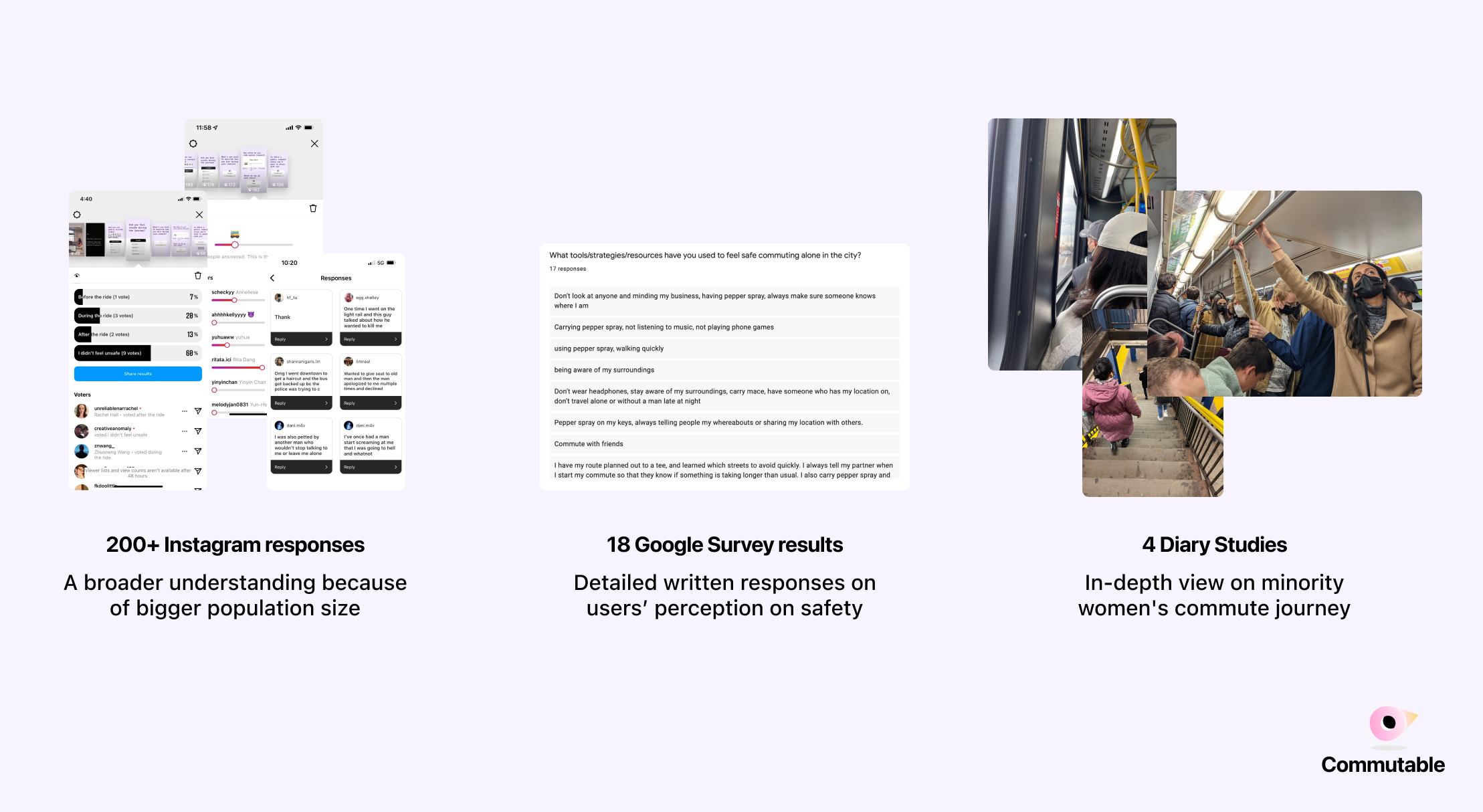
After aggregating all the results, we pulled them altogether and arranged them on an affinity map. By separating responses into each stage of the commute (beginning, during, and the end) and understanding how people’s perception of safety in a city changes after spending time there, we were surprised to learn a few things.
Who is around them impacts how people feel when they’re commuting alone. Oftentimes, having too many people around doesn’t necessarily make people feel safe; on the contrary, many participants stated that they feel more stressed when there is a huge crowd around them.
Time of the day and environment also affect people’s sentiment. They generally avoid traveling on poorly-lit streets or streets they’re not familiar with at night.
We noticed a difference between people feeling nervous versus feeling unsafe. Often, they feel nervous traveling by themselves, but dangerous situations rarely happen.
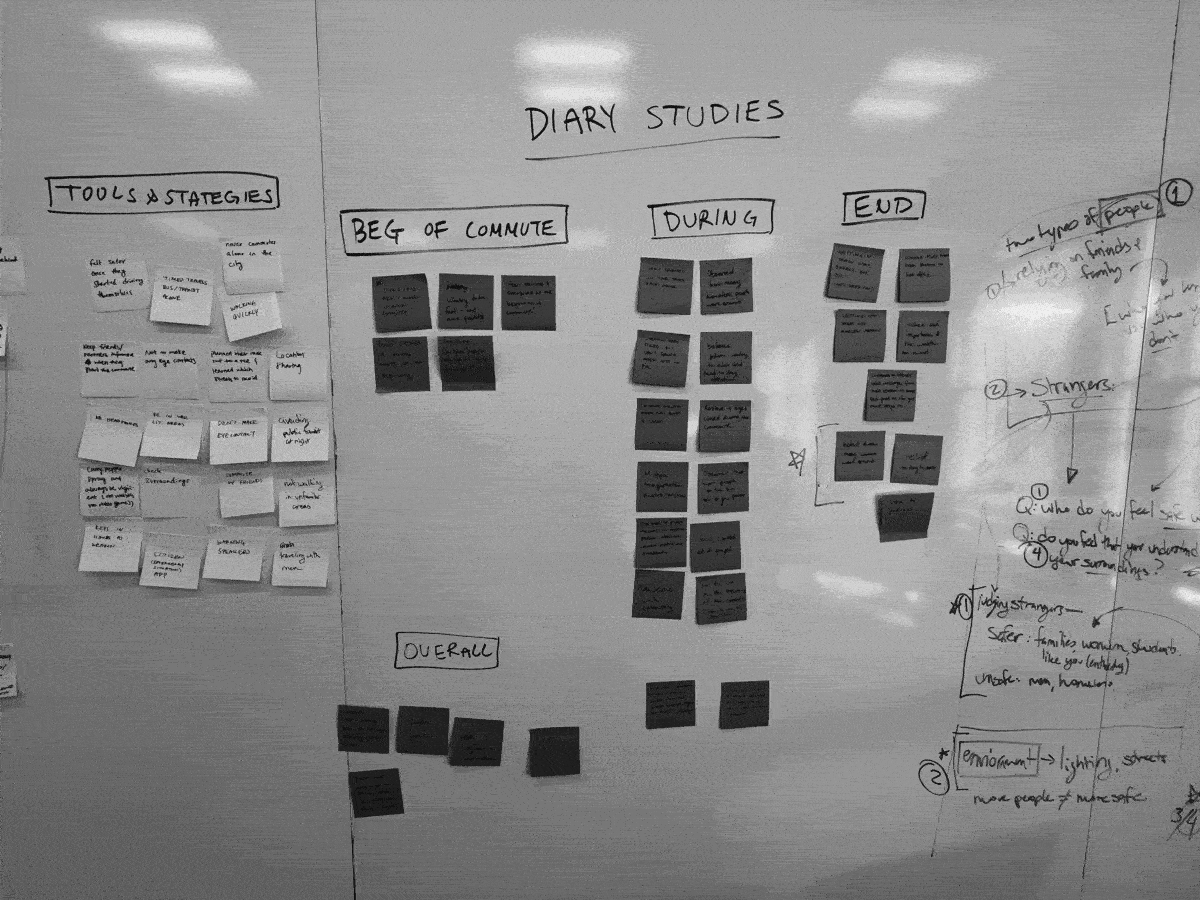
People generally feel safe when they travel with friends & family, and when they’re alone, they tend to “screen” those around them based on first impressions - they often feel the safest around people with similar social status, ethnicity, or identity as them.
People have low morale during the commute — they generally feel tired and sleepy; they want to be prepared for emergency situations but don’t want to be anxious at all times.
Moment of emergency is rare, but there is always a sense of uncertainty overshadowing women's commute.
With these key insights, we finalized our design question to be -
Keeping the key insights in mind, we developed four principles our design should strictly follow -
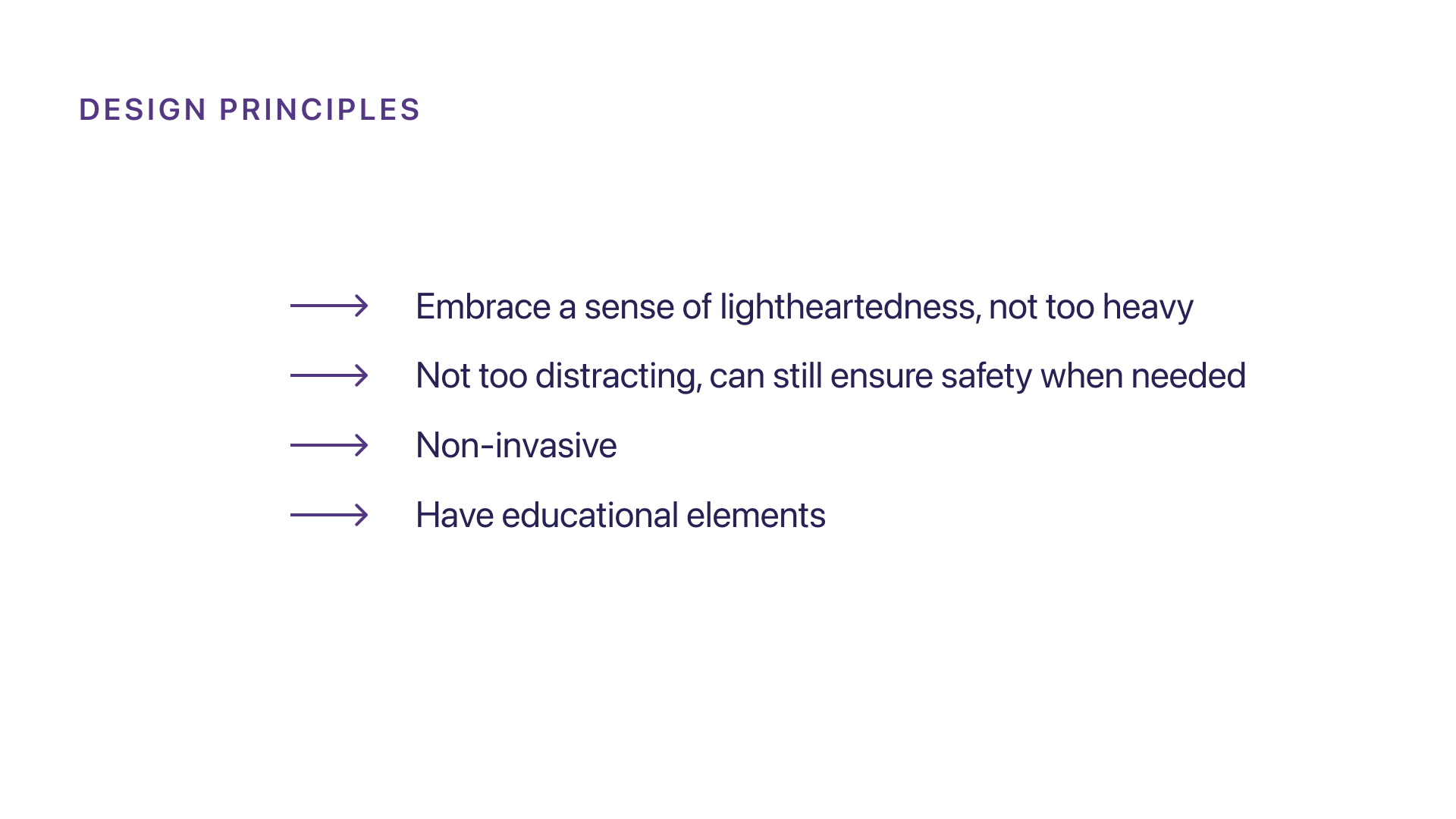
The design principles helped us brainstorm several concepts and explore each of their possibilities. One idea that stood out is to incorporate the safety feature into Spotify by having birds chirping sounds as a regular check-in mechanism. The idea ensures the product to be non-distracting and fun to use while providing the necessary functions for insuring safety during commute alone.
Inspired by our reading on Donella Meadows’ leverage points within social innovation to create change, we wanted to take this issue of safety from a systematic point of view. We wanted to integrate our product within a person’s life and have this application be seamlessly integrated with everyday life, rather than an “add-on” by downloading this additional app. Therefore, we build this final product within the space of employment and framed it within the commute to work. Co-workers can mutually check on each other’s safety and be a part of each other's commute journeys.
To create a friendly interface that is engaging to use, especially in face of potentially heavy situations of emergency, we chose to use a character (Chirpy) as a mascot and guide for the user.
After settling on our concept, we started making sketches and lo to mid- fidelity mockups to further brainstorm and evaluate the potential features. We each took a section of the user flow to explore visual directions, and then we came back to discuss and consolidate.
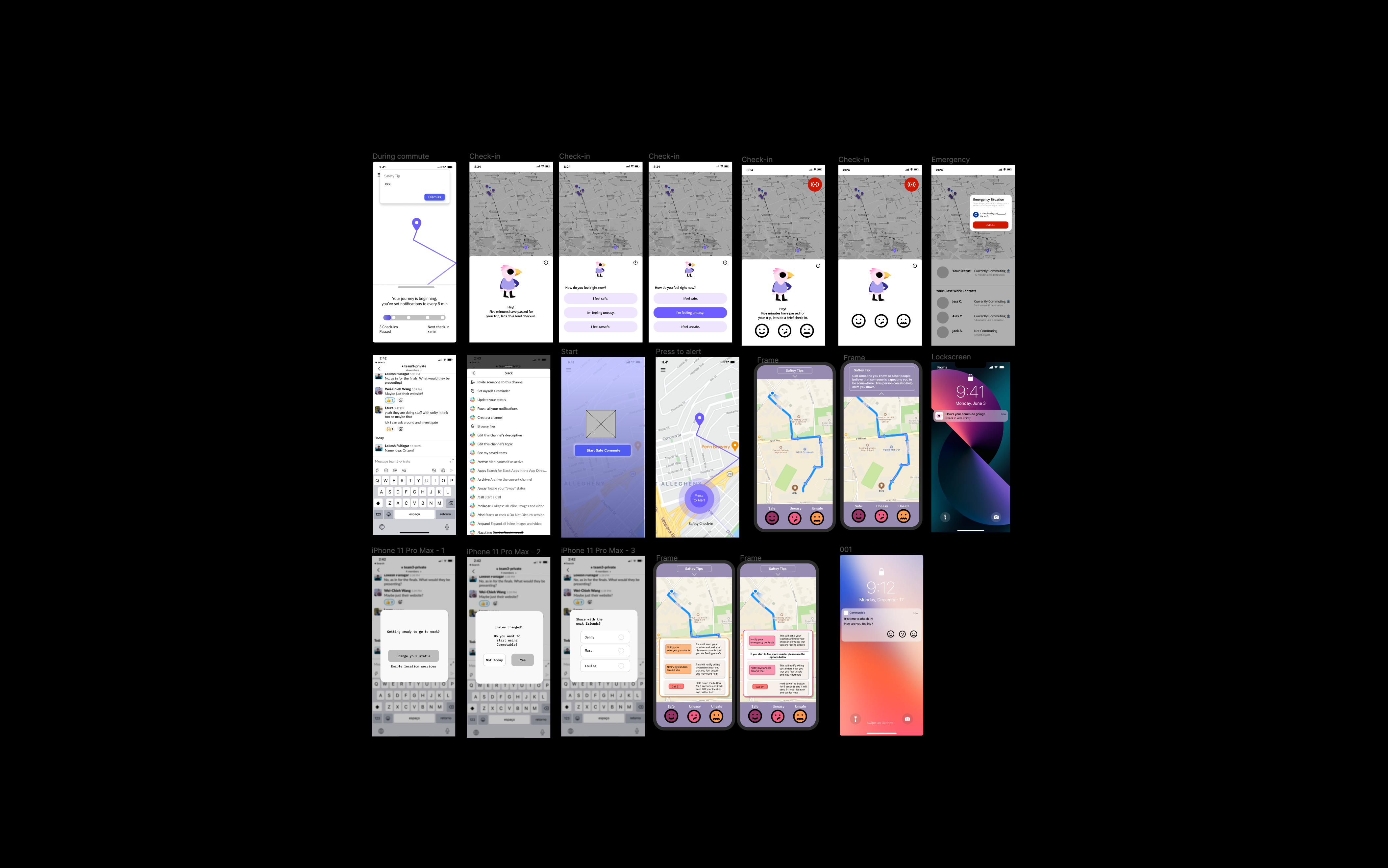
We received valuable feedback from our instructor during in-class crit for the final concept. Questions including how users send out notifications to others and whether tapping “feeling unsafe” within the app pushed us to think further on the interaction design and usability aspect of our tool.
Additionally, we discussed the concept of positive-sum during crit as well. We realized that an essential part of our tool is that it gets better when more users are in the network. For example, if more users sign up as active bystanders, those who typically feel nervous commuting alone would have more peace of mind as they know there would be bystanders around them to intervene if needed.
With this feedback in mind, we refined the proposed solution and created more user flows to enhance the user experience. We also conducted user testing sessions, which will be discussed in later sections.
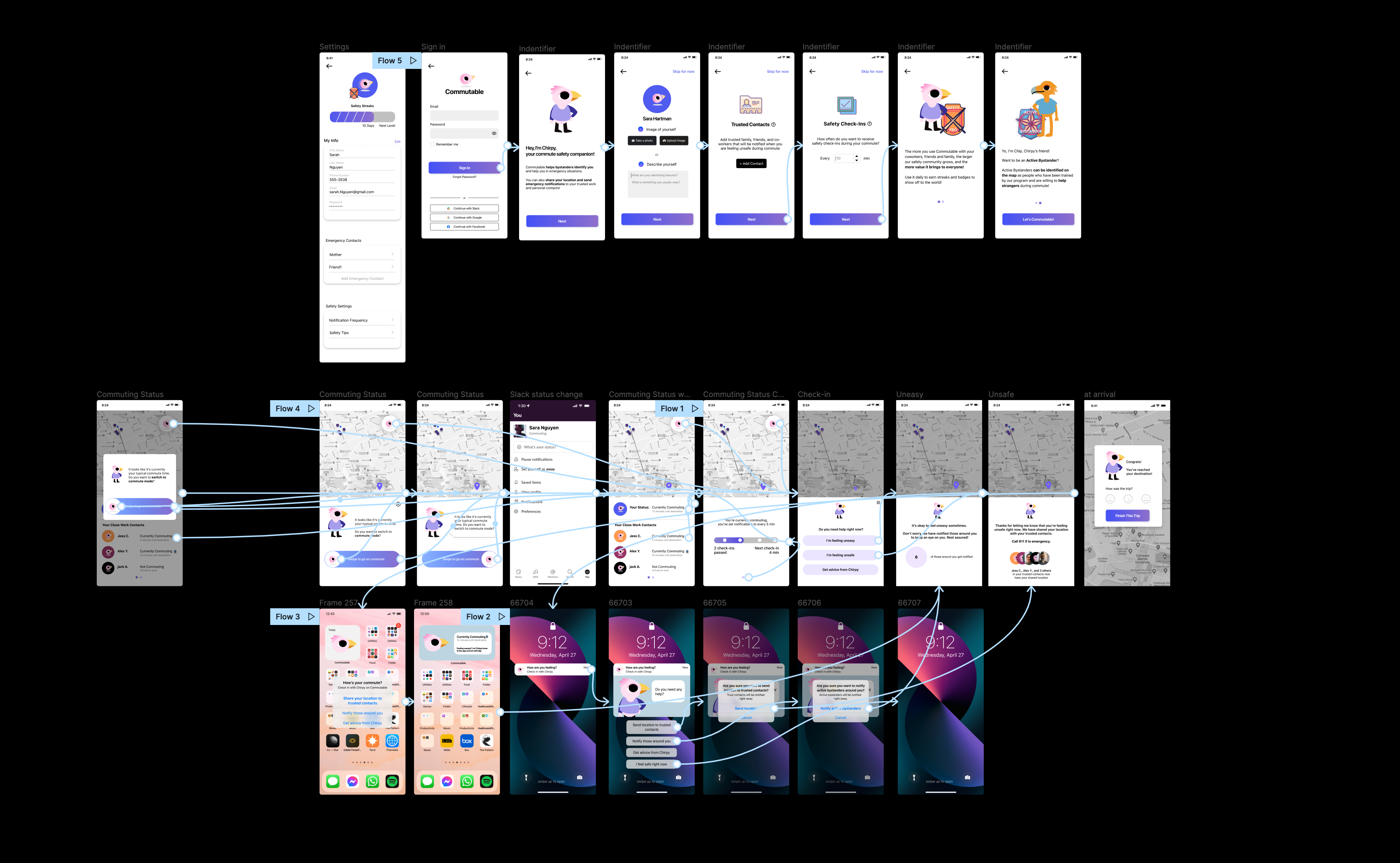
One of the critical feedback we received is the need to find the best way to check in with our users without being didactic. We proposed three options and tested them with 8 randomly recruited participants on campus.
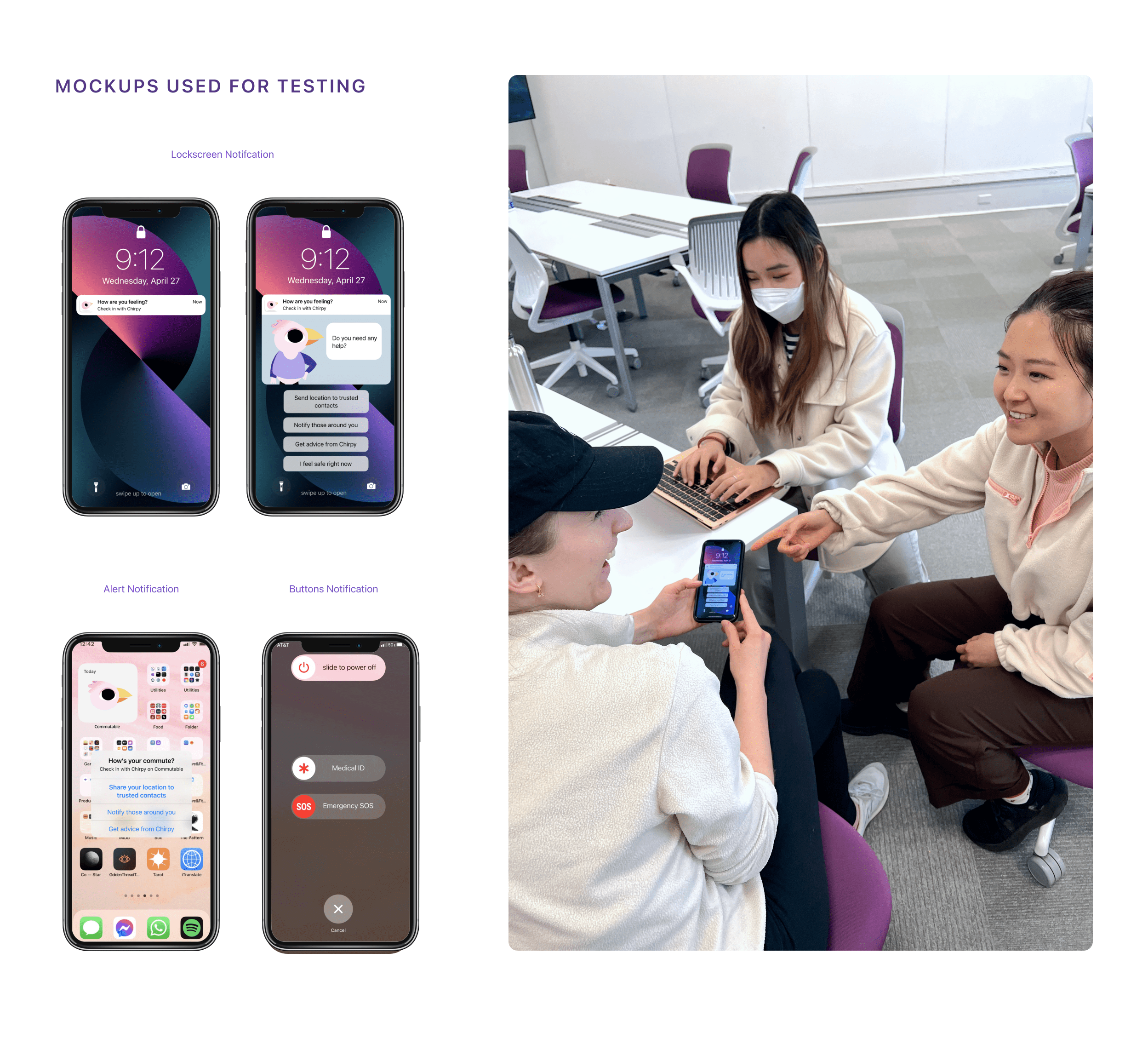
We found that users prefer lock notifications because it is easy and not invasive of their commuting activities.
Users felt like since they are not always unsafe so they want an “I’m safe button” to reassure their safety. Especially, if they hit an uneasy or unsafe button but then the situation ends up being not dangerous.
Users wanted a way to interact with and check in on their friends
After the value user testing sessions, we realized that there could be a lot of future explorations for us to consider.
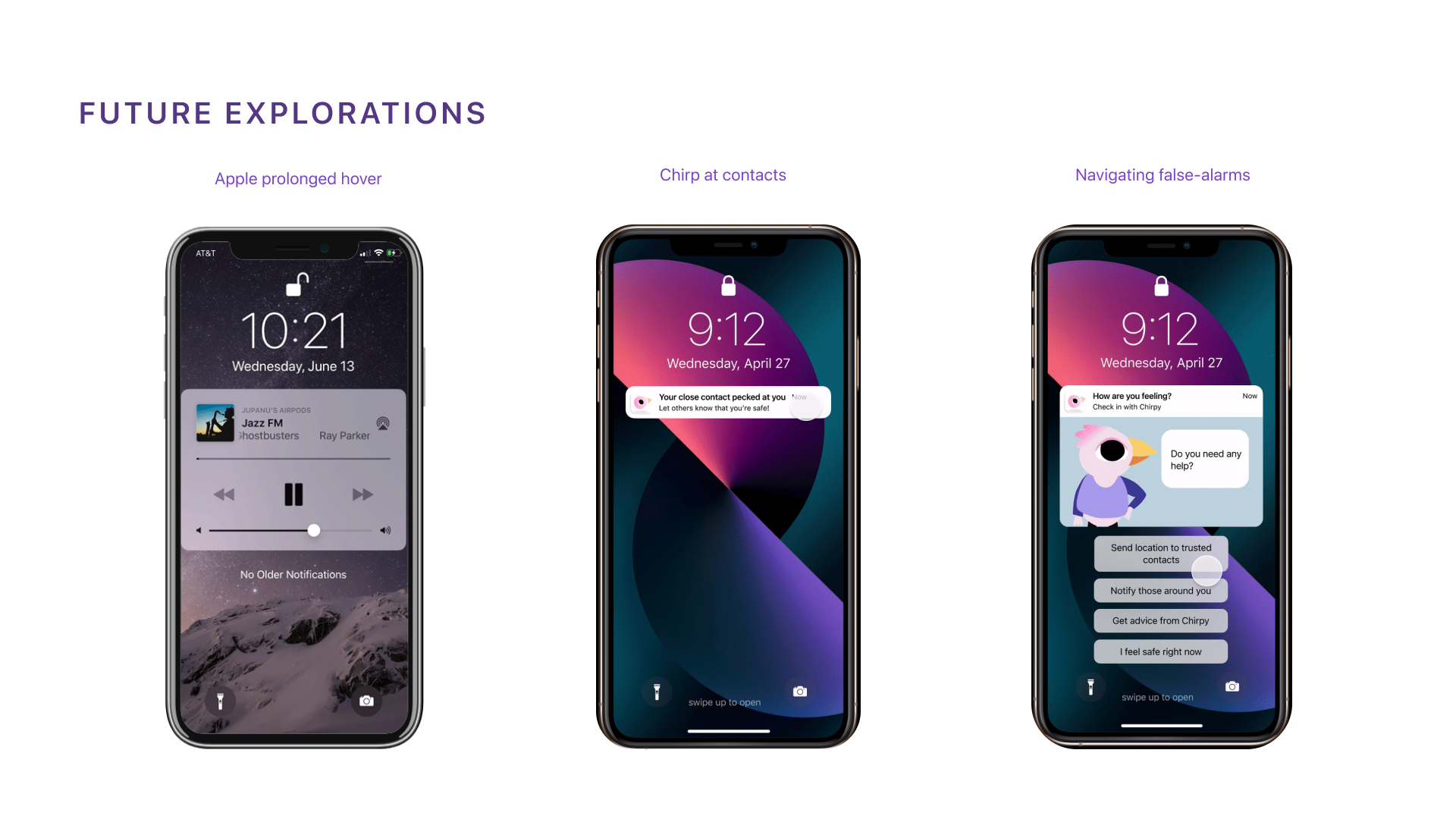
Apple Prolonged Hover: People liked the quick and accessible notifications. So a shortcut that is on the front lock screen so you can click into the app whenever you need to while commuting would be more useful than having timed check-ins because you never know when danger may arise
Chirp at Contacts: Some participants thought it would be nice if there was a feature to check in on close contacts, especially if they notified you that they were feeling uneasy. We were thinking the user could get a notification when someone is concerned and it checking in, calling it a “chirp”
Mis-click/False alarms: Many people in our user testing asked if there could be ways to navigate false alarms, especially if they accidentally missed Chirpy’s check-in, or accidentally pressed a safety function

Use of auto-location detection: Once Chirpy learns your travel route and workplace address, chirpy can promote and nudge you to turn on commutable so you don’t have to worry about remembering, but you are also not forced into starting commutable every time you leave your house.
What does bystander safety training look like?: To make the bystander system reliable and create a safe community, bystanders have to go through the commutable training program so they know how to identify a situation and act as a bystander in situations they may encounter while on public transit. This educational aspect is a key design principle of our product, and we hope to be able to explore more of this training in the future.
In addition to the opportunities for our digital product and app design, we also discovered that there are larger opportunities for growth. The endgame we vision for Commutable is replication. One key area for further expansion is to create integrations for other messaging applications often used by corporations, for example, Microsoft Teams, Discord, Google Hangouts, and Mattermost.
Additionally, we also see potential with partnerships with other transportation applications, such as Transit and Waze. Uber and Lyft have already begun building safety features into their digital experience design, however, this is very limited to an individual-by-individual basis. We believe that there are possibilities to add more educational and safety strategies.
Adoption rate of our application across multiple cities and organizations of varying sizes (large corporations to small businesses)
Trends in hate crimes and harassment to see if we can follow the impact our experience has in actual crime rates
Commuters' confidence and empowerment while commuting, both in difficult situations themselves and are able to intervene as active bystanders
I’m grateful for this opportunity of using design to tackle an issue that’s very close to my heart. From conducting secondary research, drafting a one-pager to succinctly depict the issue, to brainstorming concepts that led to our final prototype, I feel the frameworks and methods we learned in class and utilized in this project have informed me well on approaching social issues more systemically.I believe our solution could really benefit commuters through the replication method from the end game. Connecting safety measures with work networks is innovative but still practical. I’d love to keep working on this project to develop more features and functions to make it an even more comprehensive ecosystem.
Lastly, I truly enjoyed working with my team! Since we all came from different backgrounds, the discussion felt eclectic yet collaborative. I appreciate the awesome experience and my teammates!